Comprehensive Analysis of the Role of a Business Analyst in Business
VerifiedAdded on 2020/02/19
|11
|2792
|74
Report
AI Summary
This report provides a comprehensive analysis of the role of a business analyst, emphasizing the importance of analyzing the domain and organization in which work takes place and documenting the relationship between business and technology. The report focuses on core knowledge areas such as business analysis planning and monitoring, elicitation and collaboration, requirements life cycle management, strategy analysis, requirements analysis and design definition, and solution evaluation. A case study on Integrated Library System (ILS) is used to illustrate the practical application of these concepts. The report highlights the significance of strategic analysis, SWOT analysis, and solution evaluation in ensuring business competitiveness. It underscores the importance of proper planning, monitoring, collaboration, and the efficient management of requirements life cycles. The report concludes by emphasizing the crucial role of a business analyst in formulating strategies, identifying opportunities, and ensuring the overall success of a business.

Running head: THE ROLE OF A BUSINESS ANALYST
The Role of a Business Analyst
Name of Student
Name of University
Author Note
The Role of a Business Analyst
Name of Student
Name of University
Author Note
Paraphrase This Document
Need a fresh take? Get an instant paraphrase of this document with our AI Paraphraser
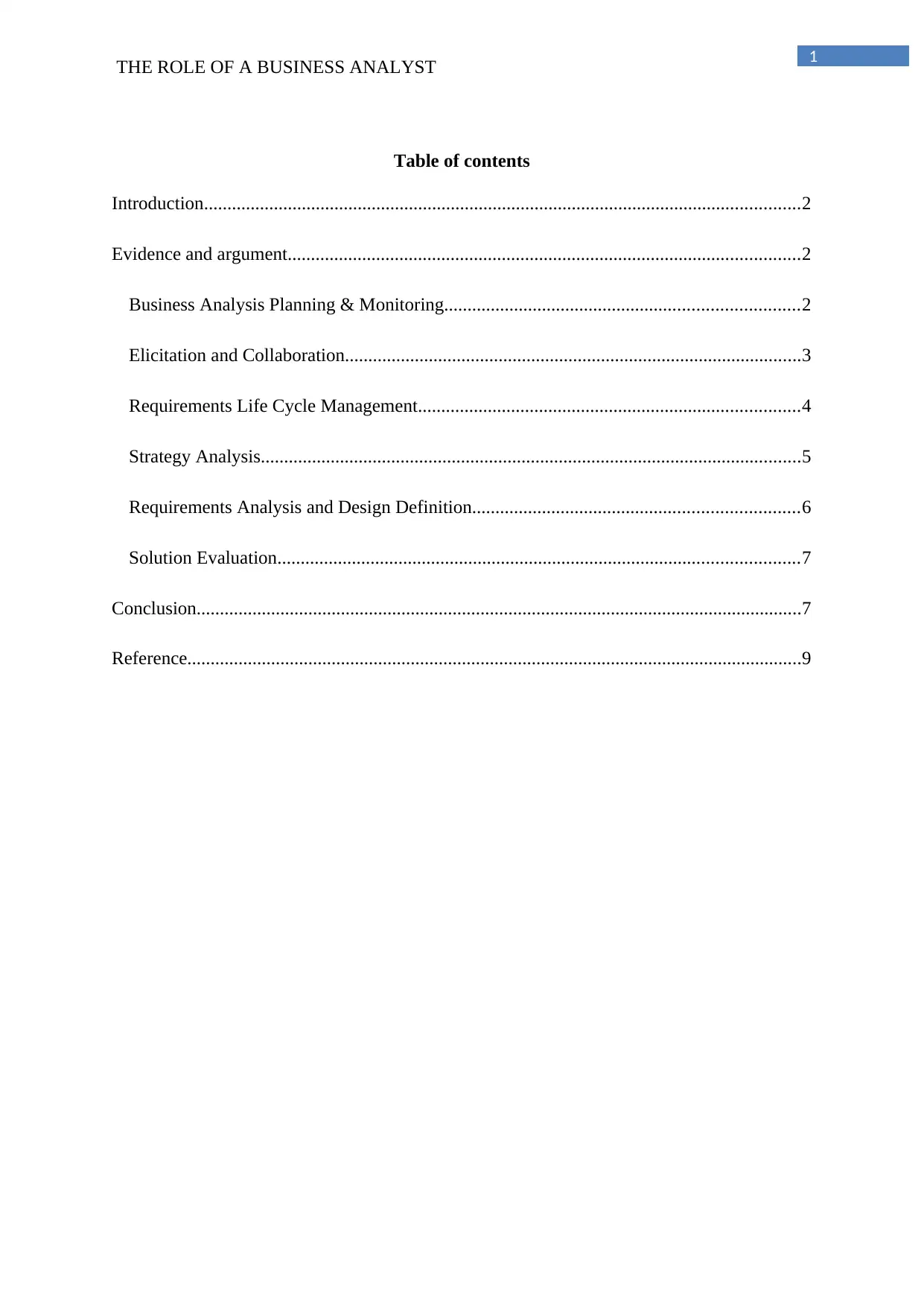
1
THE ROLE OF A BUSINESS ANALYST
Table of contents
Introduction................................................................................................................................2
Evidence and argument..............................................................................................................2
Business Analysis Planning & Monitoring............................................................................2
Elicitation and Collaboration..................................................................................................3
Requirements Life Cycle Management..................................................................................4
Strategy Analysis....................................................................................................................5
Requirements Analysis and Design Definition......................................................................6
Solution Evaluation................................................................................................................7
Conclusion..................................................................................................................................7
Reference....................................................................................................................................9
THE ROLE OF A BUSINESS ANALYST
Table of contents
Introduction................................................................................................................................2
Evidence and argument..............................................................................................................2
Business Analysis Planning & Monitoring............................................................................2
Elicitation and Collaboration..................................................................................................3
Requirements Life Cycle Management..................................................................................4
Strategy Analysis....................................................................................................................5
Requirements Analysis and Design Definition......................................................................6
Solution Evaluation................................................................................................................7
Conclusion..................................................................................................................................7
Reference....................................................................................................................................9
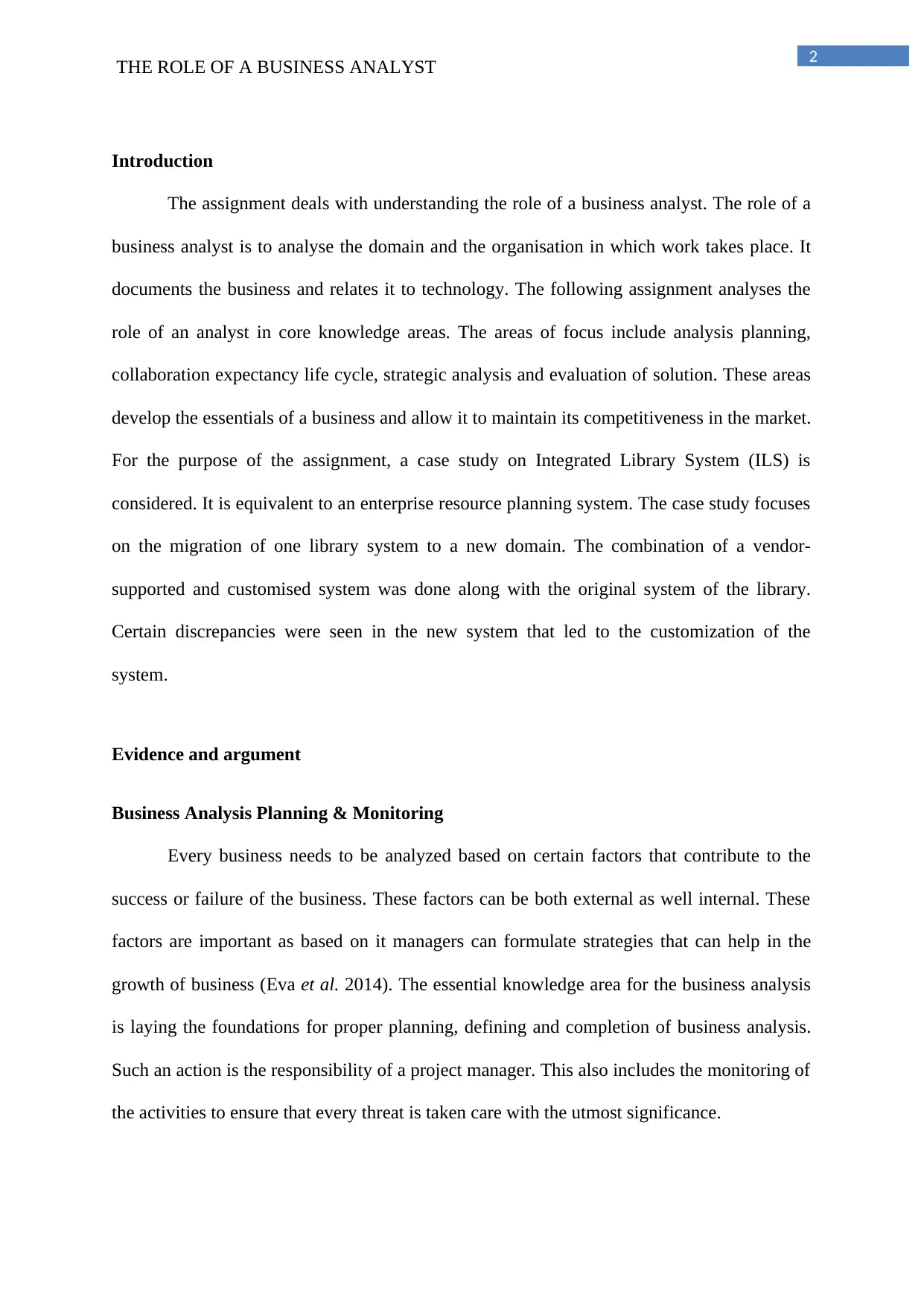
2
THE ROLE OF A BUSINESS ANALYST
Introduction
The assignment deals with understanding the role of a business analyst. The role of a
business analyst is to analyse the domain and the organisation in which work takes place. It
documents the business and relates it to technology. The following assignment analyses the
role of an analyst in core knowledge areas. The areas of focus include analysis planning,
collaboration expectancy life cycle, strategic analysis and evaluation of solution. These areas
develop the essentials of a business and allow it to maintain its competitiveness in the market.
For the purpose of the assignment, a case study on Integrated Library System (ILS) is
considered. It is equivalent to an enterprise resource planning system. The case study focuses
on the migration of one library system to a new domain. The combination of a vendor-
supported and customised system was done along with the original system of the library.
Certain discrepancies were seen in the new system that led to the customization of the
system.
Evidence and argument
Business Analysis Planning & Monitoring
Every business needs to be analyzed based on certain factors that contribute to the
success or failure of the business. These factors can be both external as well internal. These
factors are important as based on it managers can formulate strategies that can help in the
growth of business (Eva et al. 2014). The essential knowledge area for the business analysis
is laying the foundations for proper planning, defining and completion of business analysis.
Such an action is the responsibility of a project manager. This also includes the monitoring of
the activities to ensure that every threat is taken care with the utmost significance.
THE ROLE OF A BUSINESS ANALYST
Introduction
The assignment deals with understanding the role of a business analyst. The role of a
business analyst is to analyse the domain and the organisation in which work takes place. It
documents the business and relates it to technology. The following assignment analyses the
role of an analyst in core knowledge areas. The areas of focus include analysis planning,
collaboration expectancy life cycle, strategic analysis and evaluation of solution. These areas
develop the essentials of a business and allow it to maintain its competitiveness in the market.
For the purpose of the assignment, a case study on Integrated Library System (ILS) is
considered. It is equivalent to an enterprise resource planning system. The case study focuses
on the migration of one library system to a new domain. The combination of a vendor-
supported and customised system was done along with the original system of the library.
Certain discrepancies were seen in the new system that led to the customization of the
system.
Evidence and argument
Business Analysis Planning & Monitoring
Every business needs to be analyzed based on certain factors that contribute to the
success or failure of the business. These factors can be both external as well internal. These
factors are important as based on it managers can formulate strategies that can help in the
growth of business (Eva et al. 2014). The essential knowledge area for the business analysis
is laying the foundations for proper planning, defining and completion of business analysis.
Such an action is the responsibility of a project manager. This also includes the monitoring of
the activities to ensure that every threat is taken care with the utmost significance.
⊘ This is a preview!⊘
Do you want full access?
Subscribe today to unlock all pages.

Trusted by 1+ million students worldwide
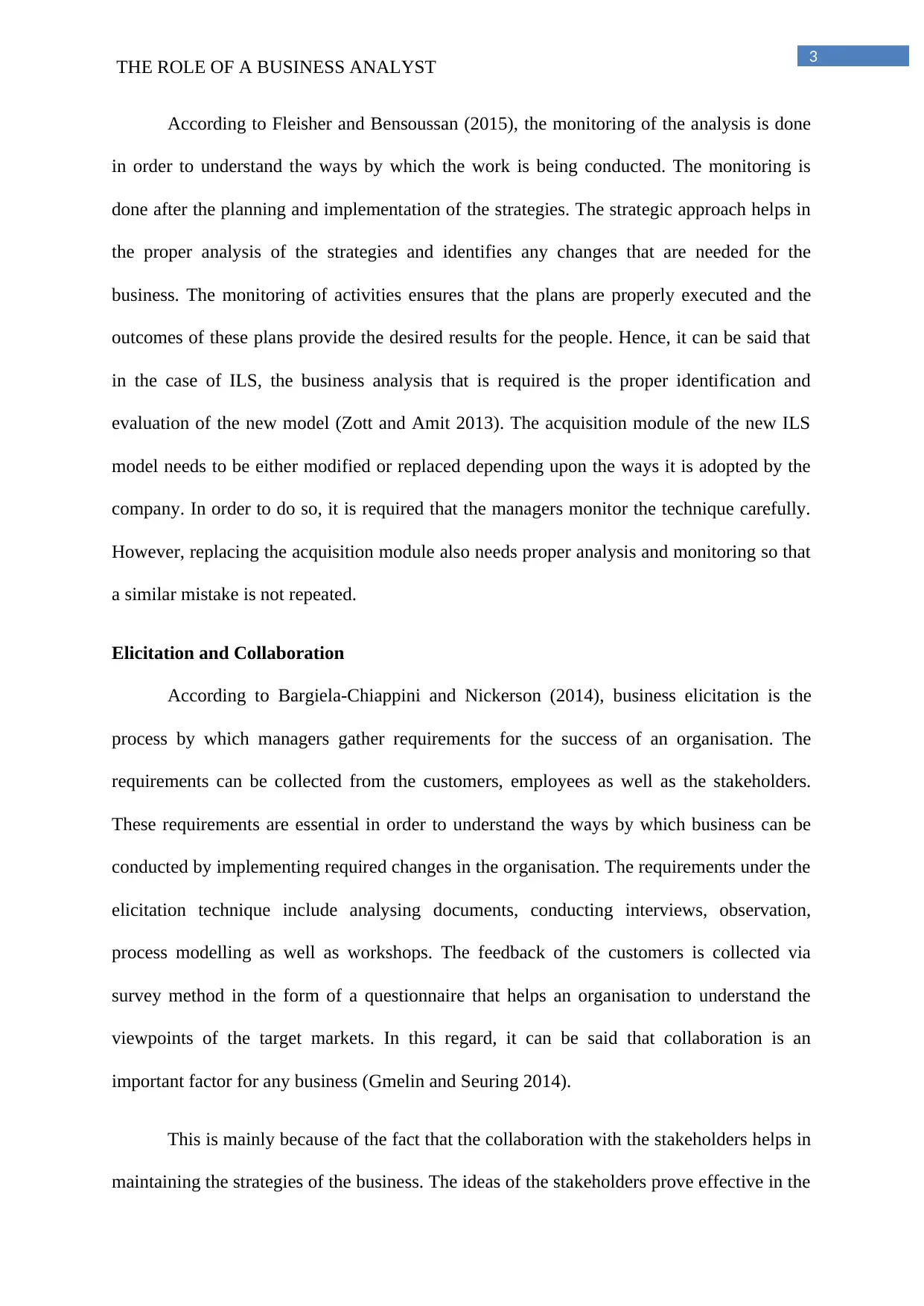
3
THE ROLE OF A BUSINESS ANALYST
According to Fleisher and Bensoussan (2015), the monitoring of the analysis is done
in order to understand the ways by which the work is being conducted. The monitoring is
done after the planning and implementation of the strategies. The strategic approach helps in
the proper analysis of the strategies and identifies any changes that are needed for the
business. The monitoring of activities ensures that the plans are properly executed and the
outcomes of these plans provide the desired results for the people. Hence, it can be said that
in the case of ILS, the business analysis that is required is the proper identification and
evaluation of the new model (Zott and Amit 2013). The acquisition module of the new ILS
model needs to be either modified or replaced depending upon the ways it is adopted by the
company. In order to do so, it is required that the managers monitor the technique carefully.
However, replacing the acquisition module also needs proper analysis and monitoring so that
a similar mistake is not repeated.
Elicitation and Collaboration
According to Bargiela-Chiappini and Nickerson (2014), business elicitation is the
process by which managers gather requirements for the success of an organisation. The
requirements can be collected from the customers, employees as well as the stakeholders.
These requirements are essential in order to understand the ways by which business can be
conducted by implementing required changes in the organisation. The requirements under the
elicitation technique include analysing documents, conducting interviews, observation,
process modelling as well as workshops. The feedback of the customers is collected via
survey method in the form of a questionnaire that helps an organisation to understand the
viewpoints of the target markets. In this regard, it can be said that collaboration is an
important factor for any business (Gmelin and Seuring 2014).
This is mainly because of the fact that the collaboration with the stakeholders helps in
maintaining the strategies of the business. The ideas of the stakeholders prove effective in the
THE ROLE OF A BUSINESS ANALYST
According to Fleisher and Bensoussan (2015), the monitoring of the analysis is done
in order to understand the ways by which the work is being conducted. The monitoring is
done after the planning and implementation of the strategies. The strategic approach helps in
the proper analysis of the strategies and identifies any changes that are needed for the
business. The monitoring of activities ensures that the plans are properly executed and the
outcomes of these plans provide the desired results for the people. Hence, it can be said that
in the case of ILS, the business analysis that is required is the proper identification and
evaluation of the new model (Zott and Amit 2013). The acquisition module of the new ILS
model needs to be either modified or replaced depending upon the ways it is adopted by the
company. In order to do so, it is required that the managers monitor the technique carefully.
However, replacing the acquisition module also needs proper analysis and monitoring so that
a similar mistake is not repeated.
Elicitation and Collaboration
According to Bargiela-Chiappini and Nickerson (2014), business elicitation is the
process by which managers gather requirements for the success of an organisation. The
requirements can be collected from the customers, employees as well as the stakeholders.
These requirements are essential in order to understand the ways by which business can be
conducted by implementing required changes in the organisation. The requirements under the
elicitation technique include analysing documents, conducting interviews, observation,
process modelling as well as workshops. The feedback of the customers is collected via
survey method in the form of a questionnaire that helps an organisation to understand the
viewpoints of the target markets. In this regard, it can be said that collaboration is an
important factor for any business (Gmelin and Seuring 2014).
This is mainly because of the fact that the collaboration with the stakeholders helps in
maintaining the strategies of the business. The ideas of the stakeholders prove effective in the
Paraphrase This Document
Need a fresh take? Get an instant paraphrase of this document with our AI Paraphraser

4
THE ROLE OF A BUSINESS ANALYST
success of a business. In the case of ILS, the libraries need to gather requirements to maintain
the process of providing books to the customers. However, the main problem lies in the bar
coding of the books. These bar coding can be done by process modelling in order to maintain
stability in the identification of the number of books. The gathering of requirements needs to
be done in such a way that there remains less pressure on the employees in terms of
maintaining records. In this regard, the collaboration is also required in order to maintain the
requirements of the stakeholders (Konaté, Sahraoui and Kolfschoten 2014). This can be done
by engaging stakeholders in the decision-making process that can help in the smooth
functioning of the bar coding system.
Requirements Life Cycle Management
Holzbaur, Ross and Rothrock (2016) stated that analysing the life cycle of a product is
important for success. This is done in order to predict the possible success rate of a product.
A product goes through four stages that determine its level of longevity in the market.
Similarly, in the case of requirements of a business organisation, the four stages exist that
determine the longevity of a particular strategy. At the initial stage when the requirement is
introduced in the business, employees begin to doubt its validity. However, with time the
requirement reaches a growth stage that sets about in the implication of the tactics for the
organisational benefit. During the maturity stage, the requirements reach its full potential and
ensure that organisational success is attained every time with the application of the
requirement.
However, with time the requirement declines and new requirements are introduced.
This is done in order to change the ways by which an organisation functions. The
requirements life cycle needs to be managed to keep in mind the excessive use of a similar
technique (Wolf et al. 2013). This is because rival companies can understand the techniques
and formulate counter measures to gain an advantage. In the case of ILS, the requirements
THE ROLE OF A BUSINESS ANALYST
success of a business. In the case of ILS, the libraries need to gather requirements to maintain
the process of providing books to the customers. However, the main problem lies in the bar
coding of the books. These bar coding can be done by process modelling in order to maintain
stability in the identification of the number of books. The gathering of requirements needs to
be done in such a way that there remains less pressure on the employees in terms of
maintaining records. In this regard, the collaboration is also required in order to maintain the
requirements of the stakeholders (Konaté, Sahraoui and Kolfschoten 2014). This can be done
by engaging stakeholders in the decision-making process that can help in the smooth
functioning of the bar coding system.
Requirements Life Cycle Management
Holzbaur, Ross and Rothrock (2016) stated that analysing the life cycle of a product is
important for success. This is done in order to predict the possible success rate of a product.
A product goes through four stages that determine its level of longevity in the market.
Similarly, in the case of requirements of a business organisation, the four stages exist that
determine the longevity of a particular strategy. At the initial stage when the requirement is
introduced in the business, employees begin to doubt its validity. However, with time the
requirement reaches a growth stage that sets about in the implication of the tactics for the
organisational benefit. During the maturity stage, the requirements reach its full potential and
ensure that organisational success is attained every time with the application of the
requirement.
However, with time the requirement declines and new requirements are introduced.
This is done in order to change the ways by which an organisation functions. The
requirements life cycle needs to be managed to keep in mind the excessive use of a similar
technique (Wolf et al. 2013). This is because rival companies can understand the techniques
and formulate counter measures to gain an advantage. In the case of ILS, the requirements
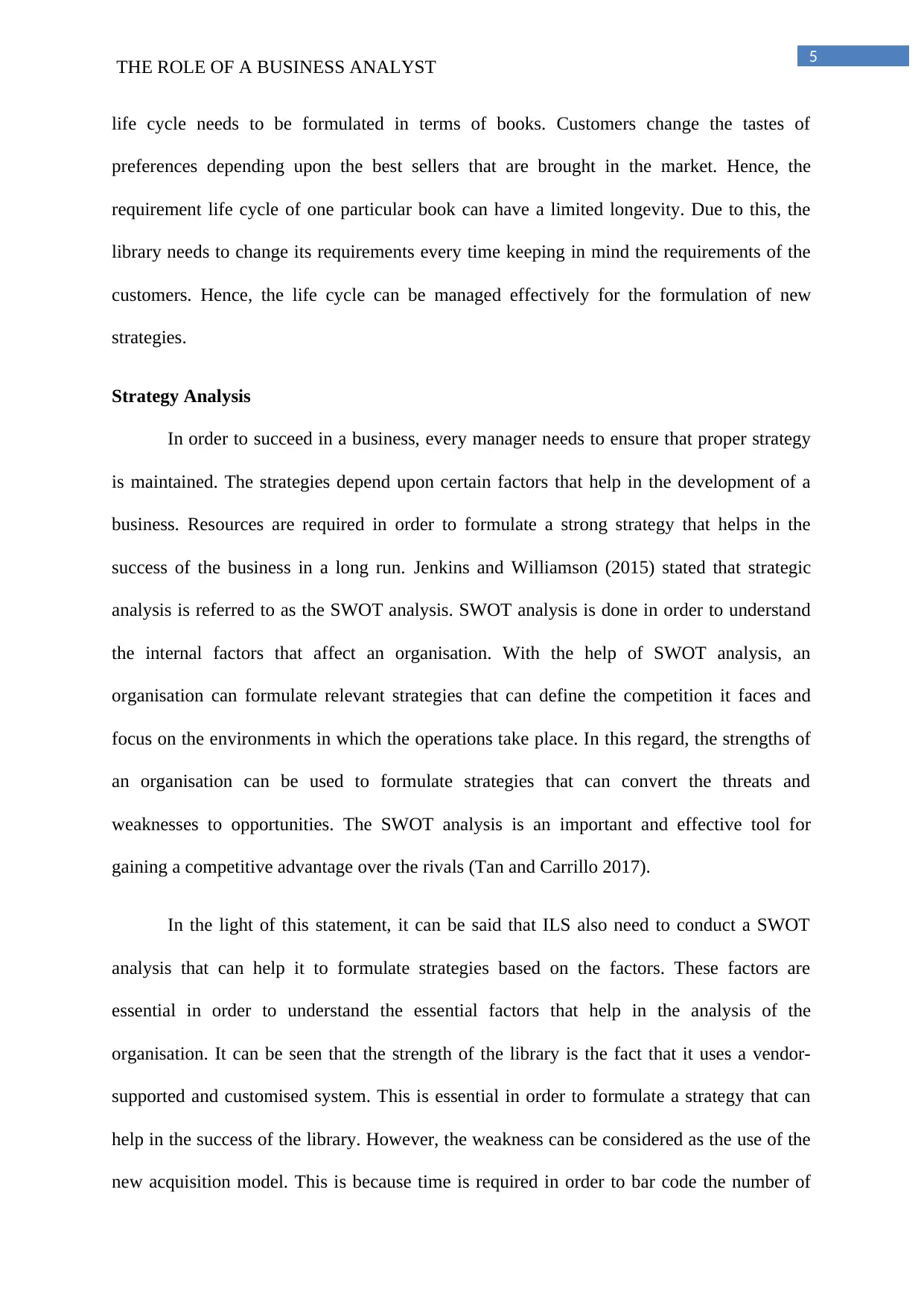
5
THE ROLE OF A BUSINESS ANALYST
life cycle needs to be formulated in terms of books. Customers change the tastes of
preferences depending upon the best sellers that are brought in the market. Hence, the
requirement life cycle of one particular book can have a limited longevity. Due to this, the
library needs to change its requirements every time keeping in mind the requirements of the
customers. Hence, the life cycle can be managed effectively for the formulation of new
strategies.
Strategy Analysis
In order to succeed in a business, every manager needs to ensure that proper strategy
is maintained. The strategies depend upon certain factors that help in the development of a
business. Resources are required in order to formulate a strong strategy that helps in the
success of the business in a long run. Jenkins and Williamson (2015) stated that strategic
analysis is referred to as the SWOT analysis. SWOT analysis is done in order to understand
the internal factors that affect an organisation. With the help of SWOT analysis, an
organisation can formulate relevant strategies that can define the competition it faces and
focus on the environments in which the operations take place. In this regard, the strengths of
an organisation can be used to formulate strategies that can convert the threats and
weaknesses to opportunities. The SWOT analysis is an important and effective tool for
gaining a competitive advantage over the rivals (Tan and Carrillo 2017).
In the light of this statement, it can be said that ILS also need to conduct a SWOT
analysis that can help it to formulate strategies based on the factors. These factors are
essential in order to understand the essential factors that help in the analysis of the
organisation. It can be seen that the strength of the library is the fact that it uses a vendor-
supported and customised system. This is essential in order to formulate a strategy that can
help in the success of the library. However, the weakness can be considered as the use of the
new acquisition model. This is because time is required in order to bar code the number of
THE ROLE OF A BUSINESS ANALYST
life cycle needs to be formulated in terms of books. Customers change the tastes of
preferences depending upon the best sellers that are brought in the market. Hence, the
requirement life cycle of one particular book can have a limited longevity. Due to this, the
library needs to change its requirements every time keeping in mind the requirements of the
customers. Hence, the life cycle can be managed effectively for the formulation of new
strategies.
Strategy Analysis
In order to succeed in a business, every manager needs to ensure that proper strategy
is maintained. The strategies depend upon certain factors that help in the development of a
business. Resources are required in order to formulate a strong strategy that helps in the
success of the business in a long run. Jenkins and Williamson (2015) stated that strategic
analysis is referred to as the SWOT analysis. SWOT analysis is done in order to understand
the internal factors that affect an organisation. With the help of SWOT analysis, an
organisation can formulate relevant strategies that can define the competition it faces and
focus on the environments in which the operations take place. In this regard, the strengths of
an organisation can be used to formulate strategies that can convert the threats and
weaknesses to opportunities. The SWOT analysis is an important and effective tool for
gaining a competitive advantage over the rivals (Tan and Carrillo 2017).
In the light of this statement, it can be said that ILS also need to conduct a SWOT
analysis that can help it to formulate strategies based on the factors. These factors are
essential in order to understand the essential factors that help in the analysis of the
organisation. It can be seen that the strength of the library is the fact that it uses a vendor-
supported and customised system. This is essential in order to formulate a strategy that can
help in the success of the library. However, the weakness can be considered as the use of the
new acquisition model. This is because time is required in order to bar code the number of
⊘ This is a preview!⊘
Do you want full access?
Subscribe today to unlock all pages.

Trusted by 1+ million students worldwide
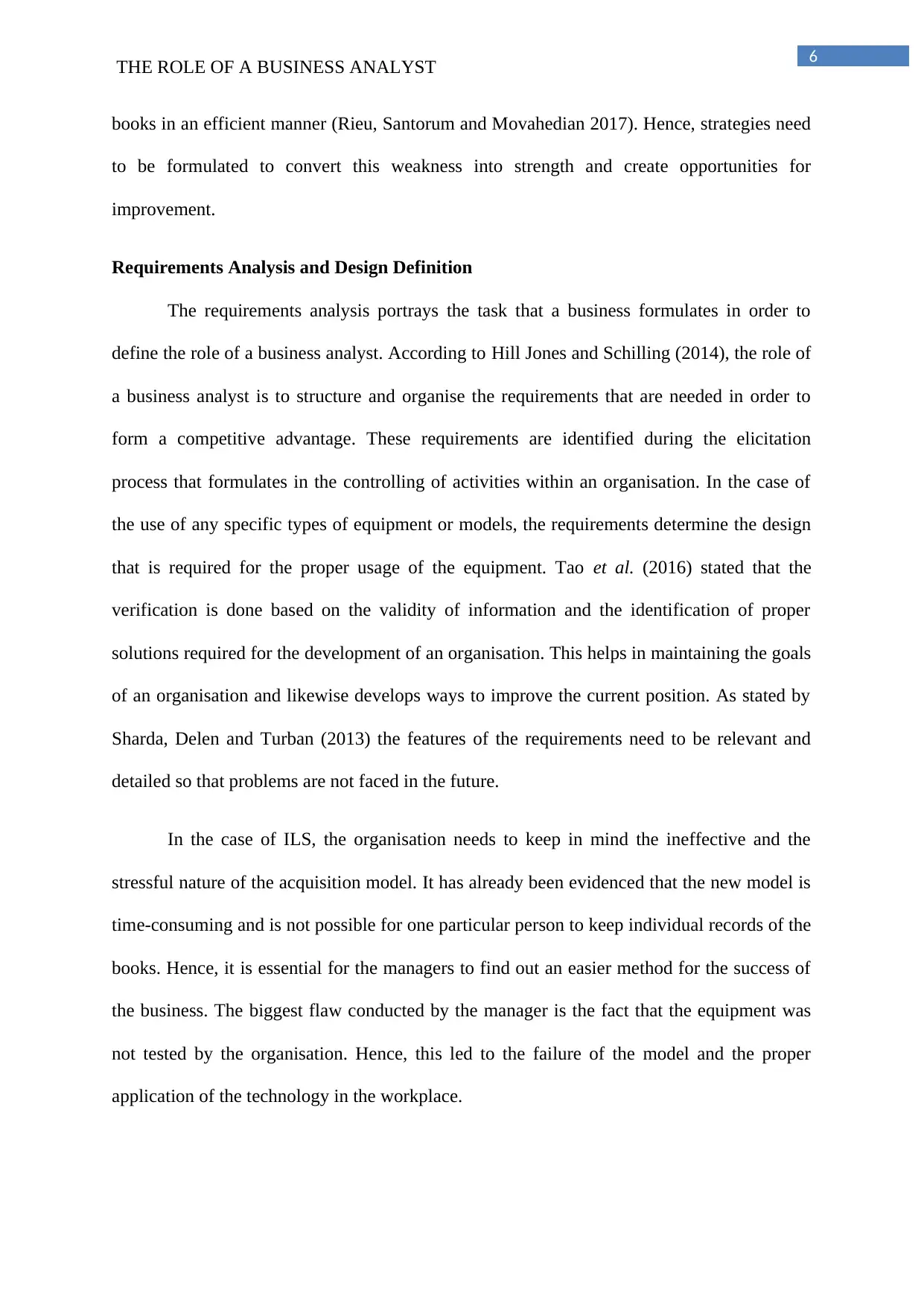
6
THE ROLE OF A BUSINESS ANALYST
books in an efficient manner (Rieu, Santorum and Movahedian 2017). Hence, strategies need
to be formulated to convert this weakness into strength and create opportunities for
improvement.
Requirements Analysis and Design Definition
The requirements analysis portrays the task that a business formulates in order to
define the role of a business analyst. According to Hill Jones and Schilling (2014), the role of
a business analyst is to structure and organise the requirements that are needed in order to
form a competitive advantage. These requirements are identified during the elicitation
process that formulates in the controlling of activities within an organisation. In the case of
the use of any specific types of equipment or models, the requirements determine the design
that is required for the proper usage of the equipment. Tao et al. (2016) stated that the
verification is done based on the validity of information and the identification of proper
solutions required for the development of an organisation. This helps in maintaining the goals
of an organisation and likewise develops ways to improve the current position. As stated by
Sharda, Delen and Turban (2013) the features of the requirements need to be relevant and
detailed so that problems are not faced in the future.
In the case of ILS, the organisation needs to keep in mind the ineffective and the
stressful nature of the acquisition model. It has already been evidenced that the new model is
time-consuming and is not possible for one particular person to keep individual records of the
books. Hence, it is essential for the managers to find out an easier method for the success of
the business. The biggest flaw conducted by the manager is the fact that the equipment was
not tested by the organisation. Hence, this led to the failure of the model and the proper
application of the technology in the workplace.
THE ROLE OF A BUSINESS ANALYST
books in an efficient manner (Rieu, Santorum and Movahedian 2017). Hence, strategies need
to be formulated to convert this weakness into strength and create opportunities for
improvement.
Requirements Analysis and Design Definition
The requirements analysis portrays the task that a business formulates in order to
define the role of a business analyst. According to Hill Jones and Schilling (2014), the role of
a business analyst is to structure and organise the requirements that are needed in order to
form a competitive advantage. These requirements are identified during the elicitation
process that formulates in the controlling of activities within an organisation. In the case of
the use of any specific types of equipment or models, the requirements determine the design
that is required for the proper usage of the equipment. Tao et al. (2016) stated that the
verification is done based on the validity of information and the identification of proper
solutions required for the development of an organisation. This helps in maintaining the goals
of an organisation and likewise develops ways to improve the current position. As stated by
Sharda, Delen and Turban (2013) the features of the requirements need to be relevant and
detailed so that problems are not faced in the future.
In the case of ILS, the organisation needs to keep in mind the ineffective and the
stressful nature of the acquisition model. It has already been evidenced that the new model is
time-consuming and is not possible for one particular person to keep individual records of the
books. Hence, it is essential for the managers to find out an easier method for the success of
the business. The biggest flaw conducted by the manager is the fact that the equipment was
not tested by the organisation. Hence, this led to the failure of the model and the proper
application of the technology in the workplace.
Paraphrase This Document
Need a fresh take? Get an instant paraphrase of this document with our AI Paraphraser
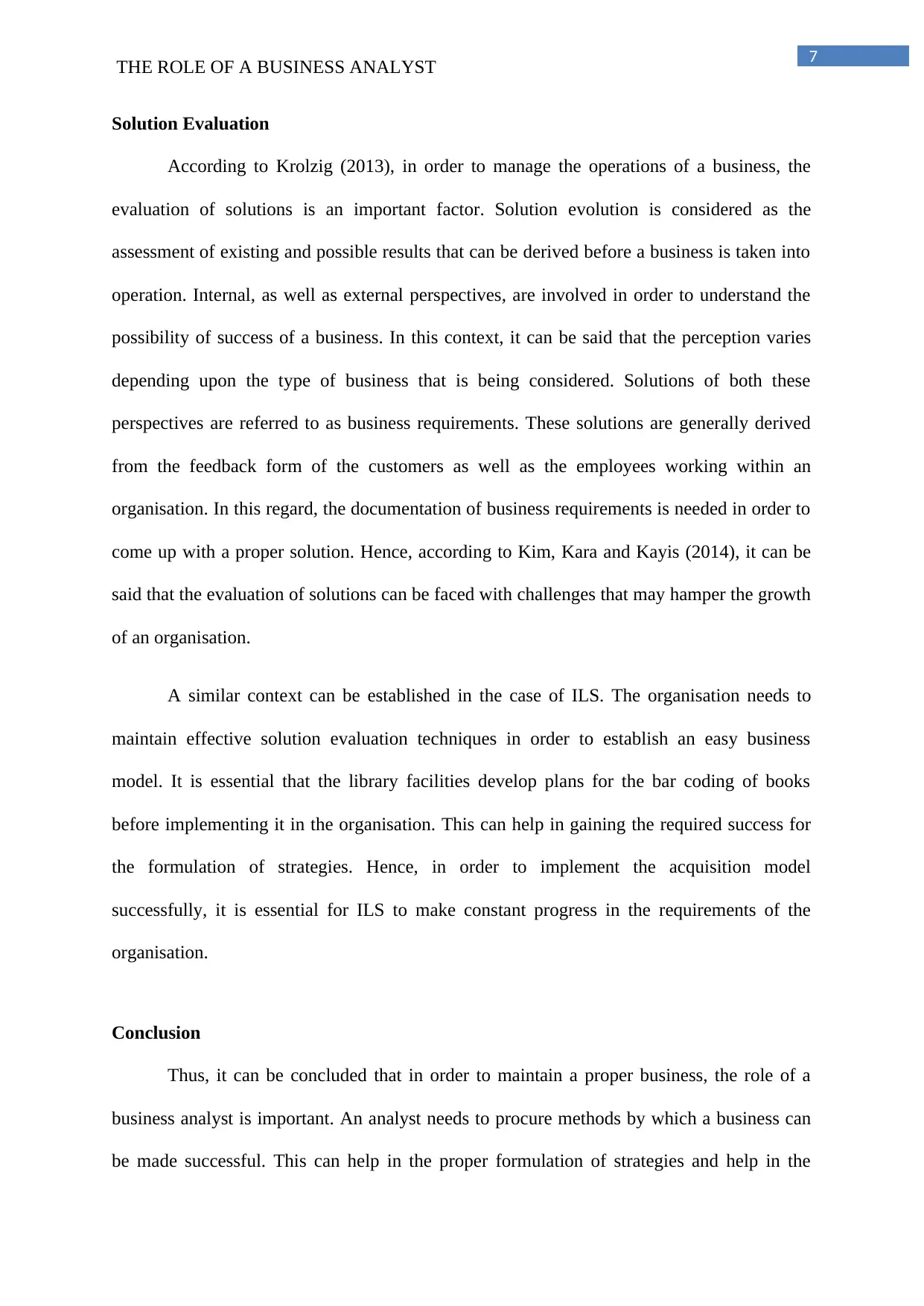
7
THE ROLE OF A BUSINESS ANALYST
Solution Evaluation
According to Krolzig (2013), in order to manage the operations of a business, the
evaluation of solutions is an important factor. Solution evolution is considered as the
assessment of existing and possible results that can be derived before a business is taken into
operation. Internal, as well as external perspectives, are involved in order to understand the
possibility of success of a business. In this context, it can be said that the perception varies
depending upon the type of business that is being considered. Solutions of both these
perspectives are referred to as business requirements. These solutions are generally derived
from the feedback form of the customers as well as the employees working within an
organisation. In this regard, the documentation of business requirements is needed in order to
come up with a proper solution. Hence, according to Kim, Kara and Kayis (2014), it can be
said that the evaluation of solutions can be faced with challenges that may hamper the growth
of an organisation.
A similar context can be established in the case of ILS. The organisation needs to
maintain effective solution evaluation techniques in order to establish an easy business
model. It is essential that the library facilities develop plans for the bar coding of books
before implementing it in the organisation. This can help in gaining the required success for
the formulation of strategies. Hence, in order to implement the acquisition model
successfully, it is essential for ILS to make constant progress in the requirements of the
organisation.
Conclusion
Thus, it can be concluded that in order to maintain a proper business, the role of a
business analyst is important. An analyst needs to procure methods by which a business can
be made successful. This can help in the proper formulation of strategies and help in the
THE ROLE OF A BUSINESS ANALYST
Solution Evaluation
According to Krolzig (2013), in order to manage the operations of a business, the
evaluation of solutions is an important factor. Solution evolution is considered as the
assessment of existing and possible results that can be derived before a business is taken into
operation. Internal, as well as external perspectives, are involved in order to understand the
possibility of success of a business. In this context, it can be said that the perception varies
depending upon the type of business that is being considered. Solutions of both these
perspectives are referred to as business requirements. These solutions are generally derived
from the feedback form of the customers as well as the employees working within an
organisation. In this regard, the documentation of business requirements is needed in order to
come up with a proper solution. Hence, according to Kim, Kara and Kayis (2014), it can be
said that the evaluation of solutions can be faced with challenges that may hamper the growth
of an organisation.
A similar context can be established in the case of ILS. The organisation needs to
maintain effective solution evaluation techniques in order to establish an easy business
model. It is essential that the library facilities develop plans for the bar coding of books
before implementing it in the organisation. This can help in gaining the required success for
the formulation of strategies. Hence, in order to implement the acquisition model
successfully, it is essential for ILS to make constant progress in the requirements of the
organisation.
Conclusion
Thus, it can be concluded that in order to maintain a proper business, the role of a
business analyst is important. An analyst needs to procure methods by which a business can
be made successful. This can help in the proper formulation of strategies and help in the
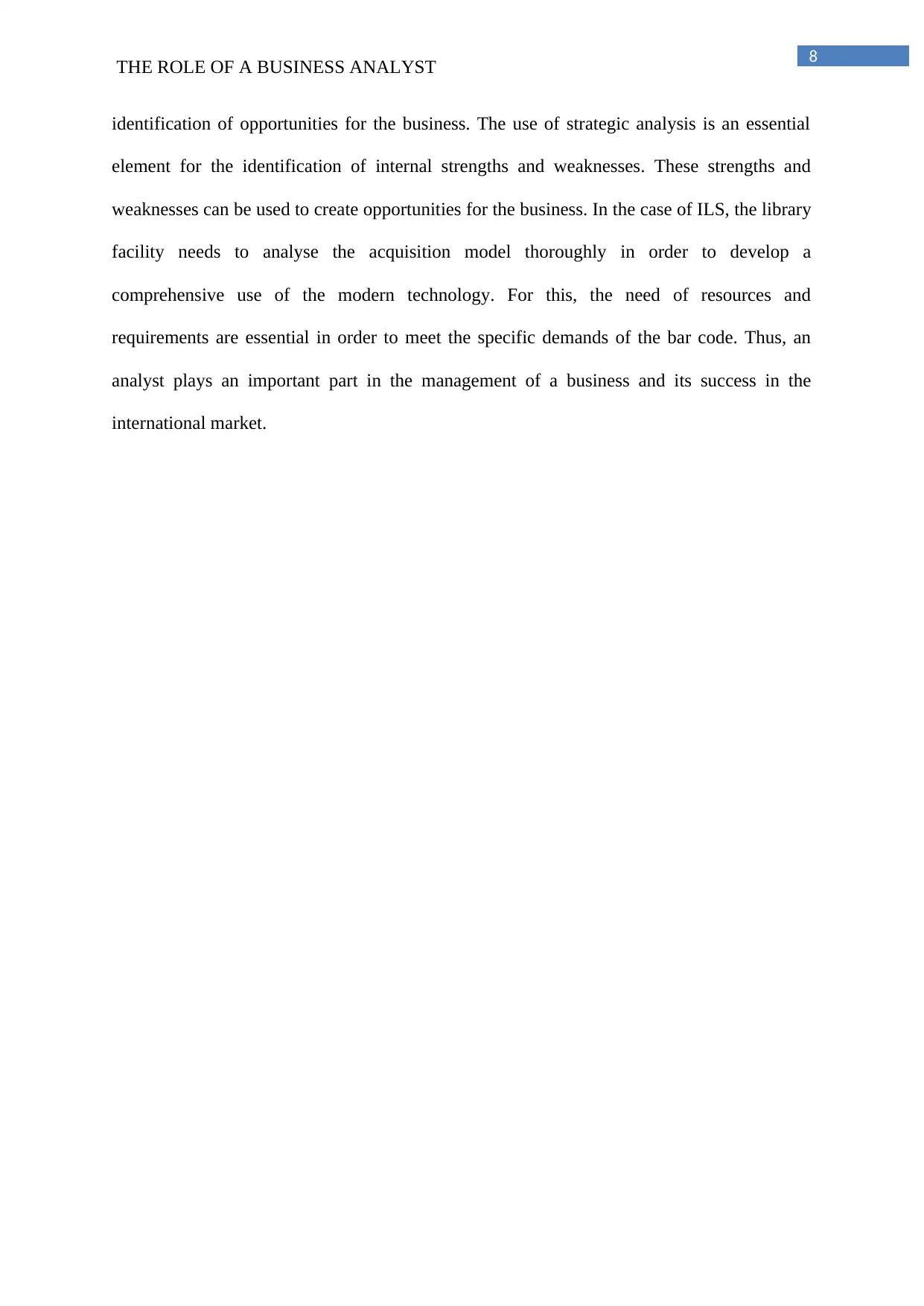
8
THE ROLE OF A BUSINESS ANALYST
identification of opportunities for the business. The use of strategic analysis is an essential
element for the identification of internal strengths and weaknesses. These strengths and
weaknesses can be used to create opportunities for the business. In the case of ILS, the library
facility needs to analyse the acquisition model thoroughly in order to develop a
comprehensive use of the modern technology. For this, the need of resources and
requirements are essential in order to meet the specific demands of the bar code. Thus, an
analyst plays an important part in the management of a business and its success in the
international market.
THE ROLE OF A BUSINESS ANALYST
identification of opportunities for the business. The use of strategic analysis is an essential
element for the identification of internal strengths and weaknesses. These strengths and
weaknesses can be used to create opportunities for the business. In the case of ILS, the library
facility needs to analyse the acquisition model thoroughly in order to develop a
comprehensive use of the modern technology. For this, the need of resources and
requirements are essential in order to meet the specific demands of the bar code. Thus, an
analyst plays an important part in the management of a business and its success in the
international market.
⊘ This is a preview!⊘
Do you want full access?
Subscribe today to unlock all pages.

Trusted by 1+ million students worldwide
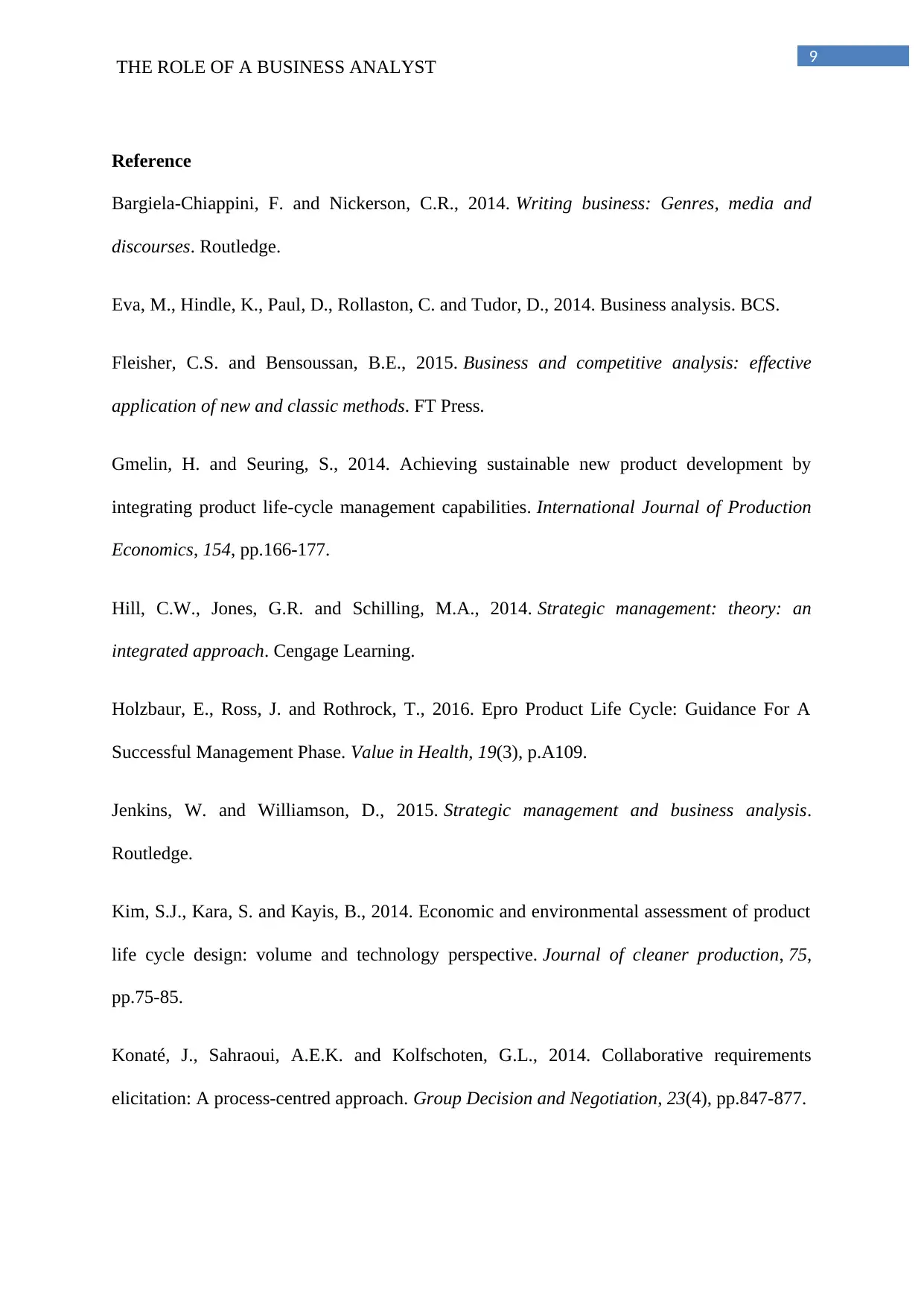
9
THE ROLE OF A BUSINESS ANALYST
Reference
Bargiela-Chiappini, F. and Nickerson, C.R., 2014. Writing business: Genres, media and
discourses. Routledge.
Eva, M., Hindle, K., Paul, D., Rollaston, C. and Tudor, D., 2014. Business analysis. BCS.
Fleisher, C.S. and Bensoussan, B.E., 2015. Business and competitive analysis: effective
application of new and classic methods. FT Press.
Gmelin, H. and Seuring, S., 2014. Achieving sustainable new product development by
integrating product life-cycle management capabilities. International Journal of Production
Economics, 154, pp.166-177.
Hill, C.W., Jones, G.R. and Schilling, M.A., 2014. Strategic management: theory: an
integrated approach. Cengage Learning.
Holzbaur, E., Ross, J. and Rothrock, T., 2016. Epro Product Life Cycle: Guidance For A
Successful Management Phase. Value in Health, 19(3), p.A109.
Jenkins, W. and Williamson, D., 2015. Strategic management and business analysis.
Routledge.
Kim, S.J., Kara, S. and Kayis, B., 2014. Economic and environmental assessment of product
life cycle design: volume and technology perspective. Journal of cleaner production, 75,
pp.75-85.
Konaté, J., Sahraoui, A.E.K. and Kolfschoten, G.L., 2014. Collaborative requirements
elicitation: A process-centred approach. Group Decision and Negotiation, 23(4), pp.847-877.
THE ROLE OF A BUSINESS ANALYST
Reference
Bargiela-Chiappini, F. and Nickerson, C.R., 2014. Writing business: Genres, media and
discourses. Routledge.
Eva, M., Hindle, K., Paul, D., Rollaston, C. and Tudor, D., 2014. Business analysis. BCS.
Fleisher, C.S. and Bensoussan, B.E., 2015. Business and competitive analysis: effective
application of new and classic methods. FT Press.
Gmelin, H. and Seuring, S., 2014. Achieving sustainable new product development by
integrating product life-cycle management capabilities. International Journal of Production
Economics, 154, pp.166-177.
Hill, C.W., Jones, G.R. and Schilling, M.A., 2014. Strategic management: theory: an
integrated approach. Cengage Learning.
Holzbaur, E., Ross, J. and Rothrock, T., 2016. Epro Product Life Cycle: Guidance For A
Successful Management Phase. Value in Health, 19(3), p.A109.
Jenkins, W. and Williamson, D., 2015. Strategic management and business analysis.
Routledge.
Kim, S.J., Kara, S. and Kayis, B., 2014. Economic and environmental assessment of product
life cycle design: volume and technology perspective. Journal of cleaner production, 75,
pp.75-85.
Konaté, J., Sahraoui, A.E.K. and Kolfschoten, G.L., 2014. Collaborative requirements
elicitation: A process-centred approach. Group Decision and Negotiation, 23(4), pp.847-877.
Paraphrase This Document
Need a fresh take? Get an instant paraphrase of this document with our AI Paraphraser
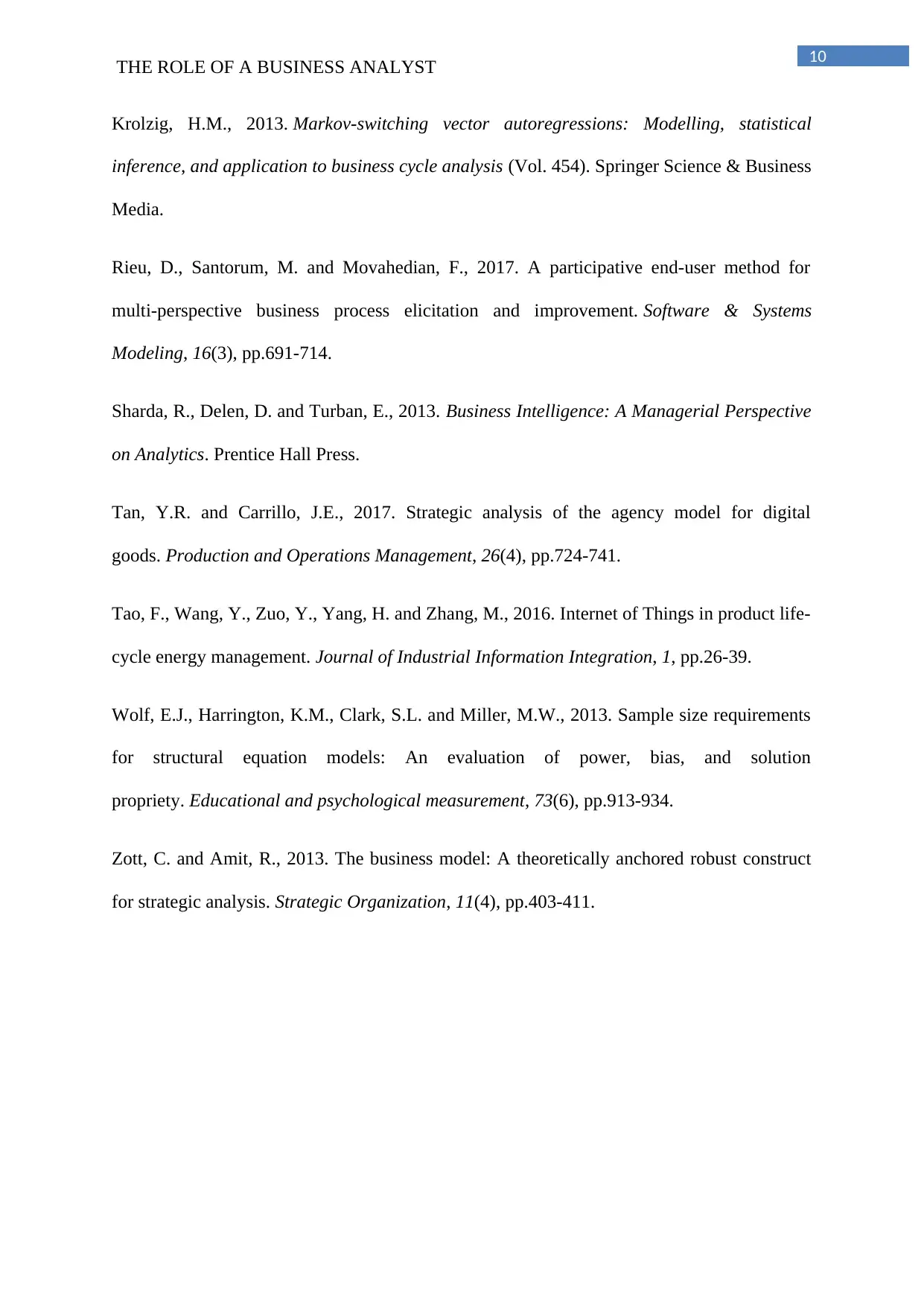
10
THE ROLE OF A BUSINESS ANALYST
Krolzig, H.M., 2013. Markov-switching vector autoregressions: Modelling, statistical
inference, and application to business cycle analysis (Vol. 454). Springer Science & Business
Media.
Rieu, D., Santorum, M. and Movahedian, F., 2017. A participative end-user method for
multi-perspective business process elicitation and improvement. Software & Systems
Modeling, 16(3), pp.691-714.
Sharda, R., Delen, D. and Turban, E., 2013. Business Intelligence: A Managerial Perspective
on Analytics. Prentice Hall Press.
Tan, Y.R. and Carrillo, J.E., 2017. Strategic analysis of the agency model for digital
goods. Production and Operations Management, 26(4), pp.724-741.
Tao, F., Wang, Y., Zuo, Y., Yang, H. and Zhang, M., 2016. Internet of Things in product life-
cycle energy management. Journal of Industrial Information Integration, 1, pp.26-39.
Wolf, E.J., Harrington, K.M., Clark, S.L. and Miller, M.W., 2013. Sample size requirements
for structural equation models: An evaluation of power, bias, and solution
propriety. Educational and psychological measurement, 73(6), pp.913-934.
Zott, C. and Amit, R., 2013. The business model: A theoretically anchored robust construct
for strategic analysis. Strategic Organization, 11(4), pp.403-411.
THE ROLE OF A BUSINESS ANALYST
Krolzig, H.M., 2013. Markov-switching vector autoregressions: Modelling, statistical
inference, and application to business cycle analysis (Vol. 454). Springer Science & Business
Media.
Rieu, D., Santorum, M. and Movahedian, F., 2017. A participative end-user method for
multi-perspective business process elicitation and improvement. Software & Systems
Modeling, 16(3), pp.691-714.
Sharda, R., Delen, D. and Turban, E., 2013. Business Intelligence: A Managerial Perspective
on Analytics. Prentice Hall Press.
Tan, Y.R. and Carrillo, J.E., 2017. Strategic analysis of the agency model for digital
goods. Production and Operations Management, 26(4), pp.724-741.
Tao, F., Wang, Y., Zuo, Y., Yang, H. and Zhang, M., 2016. Internet of Things in product life-
cycle energy management. Journal of Industrial Information Integration, 1, pp.26-39.
Wolf, E.J., Harrington, K.M., Clark, S.L. and Miller, M.W., 2013. Sample size requirements
for structural equation models: An evaluation of power, bias, and solution
propriety. Educational and psychological measurement, 73(6), pp.913-934.
Zott, C. and Amit, R., 2013. The business model: A theoretically anchored robust construct
for strategic analysis. Strategic Organization, 11(4), pp.403-411.
1 out of 11
Related Documents
Your All-in-One AI-Powered Toolkit for Academic Success.
+13062052269
info@desklib.com
Available 24*7 on WhatsApp / Email
![[object Object]](/_next/static/media/star-bottom.7253800d.svg)
Unlock your academic potential
Copyright © 2020–2025 A2Z Services. All Rights Reserved. Developed and managed by ZUCOL.





